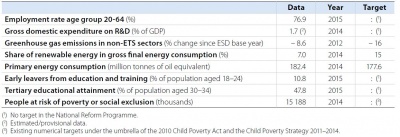Archive:Europe 2020 indicators - United Kingdom
- Data from June 2014. Most recent data: Further Eurostat information, Main tables. Planned article update: August 2017.
This article is part of a set of statistical articles on Europe 2020 strategy, focusing on the situation in the United Kingdom.
Main statistical findings

Source: Eurostat, see dedicated web section: Europe 2020 indicators
The United Kingdom has not adopted specific national Europe 2020 targets apart from the already existing climate change and renewable energy commitments (as a consequence, no radar chart can be shown for the UK). After the deterioration in employment rates during the economic crisis (2008 to 2011), the indicator increased again to 76.9 % in 2015, exceeding the EU aggregate performance of 70.1 %. In the period between 2008 and 2015, the UK managed to increase the tertiary educational attainment rate from 39.5 % to 47.8 %, against the backdrop of the adverse economic situation in the EU. The indicator on early school leavers recorded a 4.1 percentage point reduction over a four-year period, from 14.9 % in 2011 to 10.8 % in 2015. Although nearly 400 000 people were lifted out of the risk of poverty between 2013 and 2014, the number of people people at risk of poverty or social exclusion was still 1.1 million more compared to 2008. R&D expenditure increased to 1.7 % of GDP in 2014, a value close to 2008-levels. Between the ESD base year and 2012, the country had recorded a reduction of GHG emissions in non-ETS sectors of 8.6 %; further reductions of a similar magnitude would be required to meet the 16 % reduction target by 2020. With a gap of 8 percentage points in 2014, the UK was the third furthest country from its renewable energy target, after France and the Netherlands. Between 2008 and 2014, the UK managed to reduce its primary energy consumption by 27.6 Mtoe, thus shortening the gap to its 2020 target of 177.6 Mtoe.
Data sources and availability
More information about the origin of the data and the calculation of indicators can be obtained via the Europe 2020 indicators dedicated website.
Under 'Tables', click on the icons next to the indicators:
- 'Explanatory texts (metadata)' for a detailed overview of the collection and compilation methods;
- 'Information on the leaf' for data availability per country.
A more general overview of quality procedures can be found in Implementation of standard reference metadata for indicators - the ESMS Indicator Profile (ESMS-IP) (PDF file).
Context
Europe 2020 is the EU’s growth and jobs strategy for the current decade, striving to pave the way to a smart, sustainable and inclusive future. The strategy envisages measures to overcome the economic crisis and move beyond it by addressing the structural weaknesses in the European economic model. The final objective is to deliver high levels of employment, productivity and social cohesion in the Member States, while reducing the impact on the natural environment.
See also
Further Eurostat information
Publications
- Smarter, greener, more inclusive - indicators to support the Europe 2020 strategy (online publication, also downloadable as PDF file
Main tables
Dedicated section
Methodology / Metadata
- Towards robust quality management for European Statistics - Communication from the Commission to the European Parliament and the Council COM(2011) 211 final.
Other information
- Regulation 223/2009 of 11 March 2009 on European statistics